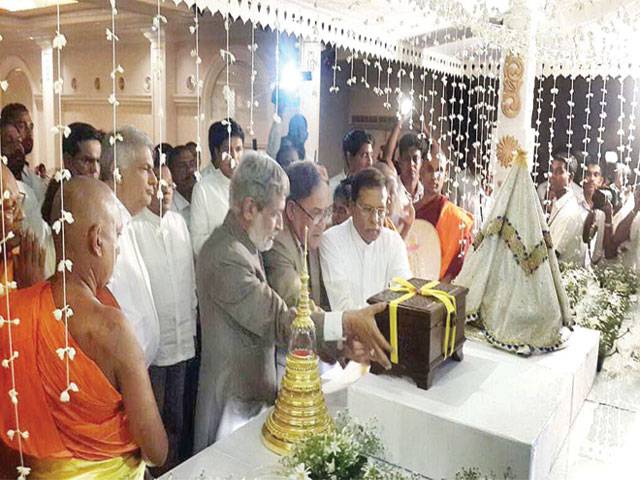ISLAMABAD - Sri Lankan President Maithripala Sirisena and Prime Minister Ranil Wickramasinghe have inaugurated an exposition of the most sacred relics of the Buddha brought from Pakistan in an impressive ceremony at Temple Trees.
A large number of senior monks/religious scholars, Speaker of the Sri Lankan Parliament Karu Jayasuriya, senior govt Ministers, high-level govt officials, Secretary Heritage Pakistan Mohsin Haqqani, Deputy High Commissioner of Pakistan Dr Sarfraz Sipra, curator of Taxila Museum as well as officers of the High Commission attended the inaugural ceremony, said a message received here from Colombo.
The sacred relics included two holy bone relics of the Buddha, a golden casket containing the relics and a stone reliquary in stupa shape.
These holy relics are part of collection from Taxila Museum of Pakistan, which is located at one of the most important archaeological sites in Asia.
The holy relics will be in Colombo for four days for public exposition and after that the relics would be taken to Gampaha (May 25-26 ), Kurunegala (May 27-28), Kalutara ( May 29-June 1st), Ratnapura ( June 2-3 ), Galle ( June 4-5 ), Matara (June 6-7), Hambantota ( June 8-9), Moneragala (June 10-11), Badulla (June 12-13), Ampara (June 14-15), Polonnaruwa ( June 16-17 ), Anuradhapura ( June 18-19) and Kandy ( June 20-21).
Afterwards, the relics will be brought back to Colombo on June 22.
The relic casket of steatite with a miniature gold casket inside containing holy bone relics were found near the Dharmarajika stupa.
The steatite casket is 7.5 inch high and has been well turned on the lath. It has adorned with shallow incised lines round its body and provided with handle on the led in the shape of a miniature casket.
Dharmarajika stupa is the earliest and the largest Buddhist religious complex at Taxila. It is situated on the bank of Dharma rivulet and was built to enshrine the redistributed holy relics of the Buddha by the famous Mauryan King Asoka the great who was also known as Dharmaraja for his services to Buddhism. Thus it named Dharmarajika.
The Gandhara civilisation was not only the center of spiritual influence but also the cradle of the world famous Gandhara culture, art and learning.






